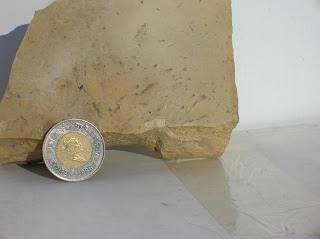Established ~ 300 B.C. and destroyed ~ 145 B.C. This is the easternmost end of the Bactrian Plain, where river Oxus meets the Kokcha river (the lapis mines are up this river). The plain is exceptionally fertile where everything but olives can grow.
Oikistes is Kineas. His sarcophagos had survived.
Items that had survived when it was excavated by the French: two types of sundials, royal hall had 18 Corinthian capitals, also 60 Doric columns in the gymnasium. The theatre had spacious, honorary seats, half-way up the rows of seats. Some pages of a lost treatise of Aristotle were found, mosaics used stones from the nearby river, storage with iron armor, Megarian bowls and gold ingots from melted-down objects.
Philosopher Clearchos of Soli, a pupil of Aristotle, visited here and brought with him a copy of the Delphic Precepts which was engraved on the funerary monument of Kineas.
"These wise sayings of the illustrious men of old have been concecrated at the sacred Pytho. There, Clearchos transcribed them carefully coming here to display them so that they shine in such a distant place, in the sacred precinct of Kineas.
AS A CHILD LEARN GOOD MANNERS
AS A YOUNG MAN LEARN TO CONTROL THY PASSIONS
IN THE MIDDLE AGE BE JUST
IN OLD AGE GIVE GOOD ADVICE, THEN DIE WITHOUT REGRETS
Oikistes is Kineas. His sarcophagos had survived.
Items that had survived when it was excavated by the French: two types of sundials, royal hall had 18 Corinthian capitals, also 60 Doric columns in the gymnasium. The theatre had spacious, honorary seats, half-way up the rows of seats. Some pages of a lost treatise of Aristotle were found, mosaics used stones from the nearby river, storage with iron armor, Megarian bowls and gold ingots from melted-down objects.
Philosopher Clearchos of Soli, a pupil of Aristotle, visited here and brought with him a copy of the Delphic Precepts which was engraved on the funerary monument of Kineas.
"These wise sayings of the illustrious men of old have been concecrated at the sacred Pytho. There, Clearchos transcribed them carefully coming here to display them so that they shine in such a distant place, in the sacred precinct of Kineas.
AS A CHILD LEARN GOOD MANNERS
AS A YOUNG MAN LEARN TO CONTROL THY PASSIONS
IN THE MIDDLE AGE BE JUST
IN OLD AGE GIVE GOOD ADVICE, THEN DIE WITHOUT REGRETS


























































